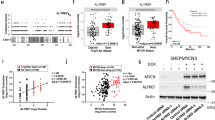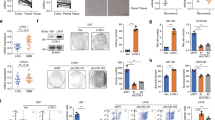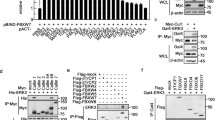Abstract
The co-chaperone protein, BAG3, which belongs to the BAG protein family, has an established antiapoptotic function in different tumor cell lines. Here we demonstrated that treatment of the human neuroblastoma cell line, SK-N-MC, with fibroblast growth factor-2 (FGF-2) results in induction of BAG3 expression. Induction of BAG3 protein by FGF-2 occurs at the transcriptional level; it requires the extracellular regulated kinase1/2 pathway and is dependent on the activity of Egr-1 upon the BAG3 promoter. Targeted suppression of BAG3 by small-interfering RNA results in dysregulation of cell-cycle progression most notably at S and G2 phases, which corroborates the decreased level of cyclin B1 expression. These observations suggest a new role for BAG3 in regulation of the cell cycle.
This is a preview of subscription content, access via your institution
Access options
Subscribe to this journal
Receive 50 print issues and online access
$259.00 per year
only $5.18 per issue
Buy this article
- Purchase on Springer Link
- Instant access to full article PDF
Prices may be subject to local taxes which are calculated during checkout





Similar content being viewed by others
References
Alzheimer C, Werner S . (2002). Fibroblast growth factors and neuroprotection. Adv Exp Med Biol 513: 335–351.
Andrews NC, Faller DV . (1991). A rapid micropreparation technique for extraction of DNA binding proteins from limiting numbers of mammalian cells. Nucleic Acids Res 19: 2499.
Baird A . (1994). Fibroblast growth factors: activities and significance of non-neurotrophic growth factors. Curr Opin Neurobiol 4: 78–86.
Basilico C, Moscatelli D . (1992). The FGF family of growth factors and oncogenes. Adv Cancer Res 59: 115–165.
Bikfalvi A, Klein S, Pintucci G, Rifkin DB . (1997). Biological roles of fibroblast growth factor-2. Endocr Rev 18: 26–45.
Carreras I, Rich CB, Jaworski JA, Dicamillo SJ, Panchenko MP, Goldstein R et al. (2001). Functional components of basic fibroblast growth factor signaling that inhibit lung elastin gene expression. Am J Physiol Lung Cell Mol Physiol 281: L766–L775.
Chiappetta G, Ammirante M, Basile A, Rosati A, Festa M, Monaco M et al. (2007). The antiapoptotic protein BAG3 is expressed in thyroid carcinomas and modulates apoptosis mediated by tumor necrosis factor-related apoptosis-inducing ligand. J Clin Endocrinol Metab 92: 1159–1163.
Doong H, Price J, Kim YS, Gasbarre C, Probst J, Liotta LA et al. (2000). CAIR-1/BAG-3 forms an EGF-regulated ternary complex with phospholipase C-γ and Hsp70/Hsc70. Oncogene 19: 4385–4395.
Doong H, Rizzo K, Fang S, Kulpa V, Weissman AM, Kohn EC . (2003). CAIR-1/BAG3 abrogates heat shock protein-70 chaperone complex-mediated protein degradation: accumulation of poly-ubiquinated Hsp90 client proteins. J Biol Chem 278: 28490–28500.
Doong H, Vrailas A, Kohn EC . (2002). What's in the ‘BAG’? A functional domain analysis of the BAG-family proteins. Cancer Lett 188: 25–32.
Gotz R, Wiese S, Takayama S, Camarero GC, Rossoll W, Schweizer U et al. (2005). Bag1 is essential for differentiation and survival of hematopoietic and neuronal cells. Nat Neurosci 8: 1169–1178.
Gremo F, Presta M . (2000). Role of fibroblast growth factor-2 in human brain: a focus on development. Int J Dev Neurosci 18: 271–279.
Gritti A, Parati EA, Cova L, Frolichsthal P, Galli R, Wanke E et al. (1996). Multipotential stem cells from the adult mouse brain proliferate and self-renew in response to basic fibroblast growth factor. J Neurosci 16: 1091–1100.
Her S, Arimochi H, Morita K . (2004). Nerve growth factor induces elevation of steroid 5 alpha-reductase mRNA levels in rat C6 glioma cells through expression of transcription factor Egr-1. Brain Res Mol Brain Res 126: 157–164.
Homma S, Iwasaki M, Shelton GD, Engvall E, Reed JC, Takayama S . (2006). AG3 deficiency results in fulminant myopathy and early lethality. Am J Pathol 169: 761–773.
Issa R, AlQteishat A, Mitsios N, Saka M, Krupinski J, Tarkowski E et al. (2005). Expression of basic fibroblast growth factor mRNA and protein in the human brain following ischaemic stroke. Angiogenesis 8: 53–62.
Kim MS, Kim CJ, Jung HS, Seo MR, Juhnn YS, Shin HY et al. (2004). Fibroblast growth factor 2 induces differentiation and apoptosis of Askin tumour cells. J Pathol 202: 103–112.
Kontaridis MI, Liu X, Zhang L, Bennett AM . (2002). Role of SHP-2 in fibroblast growth factor receptor-mediated suppression of myogenesis in C2C12 myoblasts. Mol Cell Biol 22: 3875–3891.
Lee JH, Takahashi T, Yasuhara N, Inazawa J, Kamada S, Tsujimoto Y et al. (1999). A Bcl-2-binding protein that synergizes with Bcl-2 in preventing cell death. Oncogene 18: 6183–6190.
Lee MY, Kim SY, Choi JS, Choi YS, Jeon MH, Lee JH et al. (2002b). Induction of Bis, a Bcl-2-binding protein, in reactive astrocytes of the rat hippocampus following kainic acid-induced seizure. Exp Mol Med 34: 167–171.
Lee MY, Kim SY, Shin SL, Choi YS, Lee JH, Tsujimoto Y et al. (2002a). Reactive astrocytes express bis, a bcl-2-binding protein, after transient forebrain ischemia. Exp Neurol 175: 338–346.
Liaoa Q, Ozawaa F, Friessa H, Zimmermann A, Takayama S, Reed JC et al. (2001). The anti-apoptotic protein BAG-3 is overexpressed in pancreatic cancer and induced by heat stress in pancreatic cancer cell lines. FEBS Letters 503: 151–157.
Liman J, Ganesan S, Dohm CP, Krajewski S, Reed JC, Bahr M et al. (2005). Interaction of BAG1 and Hsp70 mediates neuroprotectivity and increases chaperone activity. Mol Cell Biol 25: 3715–3725.
Lowe B, Avila HA, Bloom FR, Gleeson M, Kusser W . (2003). Quantitation of gene expression in neuronal precursors by reverse-transcription polymerase chain reaction using self-quenched, fluorogenic primers. Anal Biochem 315: 95–105.
Midgley VC, Khachigian LM . (2004). Fibroblast growth factor-2 induction of platelet-derived growth factor-C chain transcription in vascular smooth muscle cells is ERK-dependent but not JNK-dependent and mediated by Egr-1. J Biol Chem 279: 40289–40295.
O'Donovan KJ, Tourtellotte WG, Millbrandt J, Baraban JM . (1999). The EGR family of transcription-regulatory factors: progress at the interface of molecular and systems neuroscience. Trends Neurosci 22: 167–173.
Pagliuca MG, Lerose R, Cigliano S, Leone A . (2003). Regulation by heavy metals and temperature of the human BAG-3 gene, a modulator of Hsp70 activity. FEBS Lett 541: 11–15.
Romano MF, Festa M, Pagliuca G, Lerose R, Bisogni R, Chiurazzi F et al. (2003a). BAG3 protein controls B-chronic lymphocytic leukaemia cell apoptosis. Cell Death Diff 10: 383–385.
Romano MF, Festa M, Petrella A, Rosati A, Pascale M, Bisogni R et al. (2003b). A. BAG3 protein regulates cell survival in childhood acute lymphoblastic leukemia cells. Cancer Biol Ther 2: 508–510.
Rosati A, Ammirante M, Gentilella A, Basile A, Festa M, Pascale M et al. (2007a). Apoptosis inhibition in cancer cells: a novel molecular pathway that involves BAG3 protein. Int J Biochem Cell Biol 39: 1337–1342.
Rosati A, Leone A, Del Valle L, Amini S, Khalili K, Turco MC . (2007b). Evidence for BAG3 modulation of HIV-1 gene transcription. J Cell Physiol 210: 676–683.
Rössler OG, Thiel G . (2004). Brain-derived neurotrophic factor-, epidermal growth factor-, or A-Raf-induced growth of HaCaT keratinocytes requires extracellular signal-regulated kinase. Am J Physiol Cell Physiol 286: C1118–C1129.
Russo VC, Andaloro E, Fornaro SA, Najdovska S, Newgreen DF, Bach LA et al. (2004). Fibroblast growth factor-2 over-rides insulin-like growth factor-1 induced proliferation and cell survival in human neuroblastoma cells. J Cell Physiol 199: 371–380.
Schwartz SM, Liaw L . (1993). Growth control and morphogenesis in the development and pathology of arteries. J Cardiovasc Pharmacol 21 (Suppl): S31–S49.
Smits VA, van Peer MA, Essers MA, Klopmaker R, Rijksen G, Medema RH . (2000). Negative growth regulation of SK-N-MC cells by bFGF defines a growth factor-sensitive point in G2. J Biol Chem 275: 19375–19381.
Song J, Takeda M, Morimoto R . (2001). BAG1-Hsp70 mediates a physiological stress signaling pathway that regulates Raf-1/ERK and cell growth morphogenesis. Nat Cell Biol 3: 276–282.
Takayama S, Xie Z, Reed JC . (1999). An evolutionarily conserved family of Hsp70/Hsc70 molecular chaperone regulators. J Biol Chem 274: 781–786.
Temple S, Qian X . (1995). bFGF, neurotrophins, and the control of cortical neurogenesis. Neuron 15: 249–252.
Thiel G, Cibelli G . (2002). Regulation of life and death by the zinc finger transcription factor Egr-1. J Cell Physiol 193: 287–292.
Vogel S, Kubin T, von der Ahe D, Deindl E, Schaper W, Zimmermann R . (2006). MEK hyperphosphorylation coincides with cell cycle shut down of cultured smooth muscle cells. J Cell Physiol 206: 25–34.
Zapata JM, Takahashi R, Salvesen GS, Reed JC . (1998). Granzyme release and caspase activation in activated human T-lymphocytes. J Biol Chem 273: 6916–6920.
Acknowledgements
We thank past and present members of the Department of Neuroscience and Center for Neurovirology for sharing of ideas and reagents, and their encouragement throughout this study. We also thank Dr Francesca Peruzzi, Dr Davide Eletto and Dr Thersa M Sweet for their advices, William Yen and Jessica Otte for their technical support, Dr Martyn White for his time and assistance in the preparation of the manuscript and C Schriver for editorial assistance. This study is dedicated to our friend and colleague, Dr Arturo Leone. This work was made possible by grants awarded by NIH to KK.
Author information
Authors and Affiliations
Corresponding author
Rights and permissions
About this article
Cite this article
Gentilella, A., Passiatore, G., Deshmane, S. et al. Activation of BAG3 by Egr-1 in response to FGF-2 in neuroblastoma cells. Oncogene 27, 5011–5018 (2008). https://doi.org/10.1038/onc.2008.142
Received:
Revised:
Accepted:
Published:
Issue Date:
DOI: https://doi.org/10.1038/onc.2008.142
Keywords
This article is cited by
-
The critical role of HMGA2 in regulation of EMT in epithelial ovarian carcinomas
Tumor Biology (2016)
-
High expression of BAG3 predicts a poor prognosis in human medulloblastoma
Tumor Biology (2016)
-
BAG3: a new player in the heart failure paradigm
Heart Failure Reviews (2015)
-
BAG3 regulates epithelial–mesenchymal transition and angiogenesis in human hepatocellular carcinoma
Laboratory Investigation (2014)
-
BAG3 controls angiogenesis through regulation of ERK phosphorylation
Oncogene (2012)



